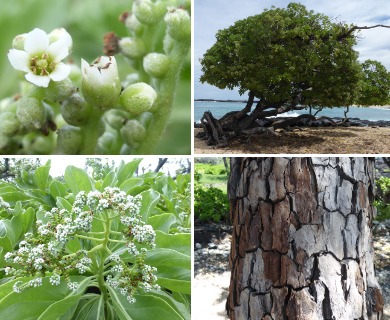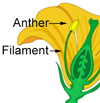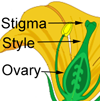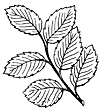Tree Heliotrope
Heliotropium arboreum
Heliotrope family (Heliotropiaceae)
Post-Cook introduction
This distinctive small umbrella-shaped tree with very short trunk, low widely forking branches, and very broad rounded spreading of gray green foliage, was introduced on sandy shores. To 20 ft (6 ), with trunk to 1 ft (0.3 ) in diameter and to 40 ft (12 ) across, often flowering as a low shrub. Bark light brown or gray, rough, very thick, deeply furrowed into narrow oblong plates and ridges. Outer bark streaky blackish brown, Inner bark is light brown, fibrous, tasteless. Twigs stout, finely hairy, gray green, becoming brown, with raised half-round leaf scars and buds of small overlapping leaves.

©2018 Zoya Akulova
Flower clusters () 6–8 inches (15 ) long including long stalks, the many branches curved to one side. Flowers many, crowded, stalkless, erect on horizontal curved or coiled branches, bell-shaped, less than 1⁄4 inch (6 ) long and broad, composed of five rounded hairy gray green white with short hairy tube and five spreading rounded five tiny in notches of and with conical and slightly two-
rounded, flattened, about 1⁄4 inch (6 ) in diameter, smooth and shiny, green, slightly watery, containing two or four large half-round brown nutlets 1⁄8 inch (3 ) long, embedded in a corky or spongy mass.
It is reported that in India the leaves are eaten raw. They have a slightly salty flavor and might be served in salads or cooked as greens. The corky mass of nutlets may be carried by ocean currents.
This is an ornamental tree planted and hardy along sandy beaches. Scattered on shores through the Hawaiian Islands. Listed by Hillebrand as in cultivation, apparently before his departure in 1871.
Special area
Waimea Arboretum
Champion
Height 32 ft (9.8 ), c.b.h. 31.5 ft (9.6 ), spread 46 ft (14.0 ). Puako Kawaihae, Hawaii (1968).
Range
Native from India in tropical Asia to Mauritius, Malaya, tropical Australia, western Indian Ocean islands, Polynesia, and Micronesia.
Other common names
velvetleaf; hunig (Guam); huni (N. Marianas); aseri (Palau); chel (Yap); chen yamolehat (Truk); titin (Pohnpei); srusrun (Kosrae); kiden (Marshalls); tausuni (Am. Samoa).
Botanical
Tournefortia argentea L. f., Messerschmidia argentea (L. f.) I. Johnst.







